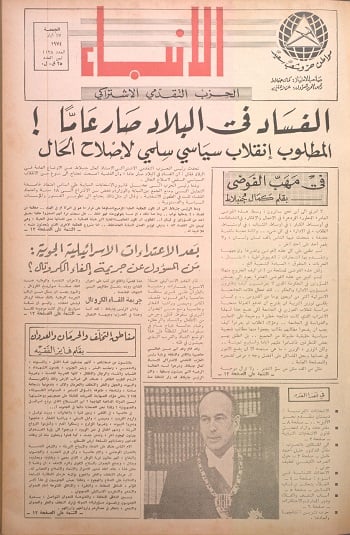Russia Is Repeating Cold War Mistakes in Syria
David W. Lesch / Foreign Policy
9 أكتوبر 2015

In 1989, I visited Latakia for the first time. I was a poor graduate student conducting research for my dissertation on U.S.-Syrian relations in the 1950s, and I’d gone to the cosmopolitan coastal city while on my way to Turkey. I stayed in a rather cheap hotel adjacent to the port, right next to a docked Soviet cruiser. One evening I did shots of vodka late into the night with some Soviet sailors at a seaside restaurant.
The next morning, my slumber was disturbed when the window in my hotel room shattered. The cause was a series of loud blasts just outside. They turned out to be explosions on the cruiser. An accident? An Israeli attack? A U.S. strike? It lasted only a few short minutes — and no one could tell me what it was. A couple days later, when I had crossed into Turkey, I found out that two Syrian helicopter gunships had attacked the cruiser, killing two Soviet sailors. But this was puzzling; the Soviet Union was Syria’s long-time superpower patron. Was it simply two crazed or incredibly incompetent Syrian pilots? Or was it a not-so-subtle message from Hafez al-Assad to Mikhail Gorbachev that Damascus did not like the direction of Syrian-Soviet relations at the time — specifically that Moscow had warmed to the West and was pressuring Damascus to make strategic peace with Israel?
To this day, no one knows the truth behind what happened. But whatever the reason, that incident, now largely forgotten, revealed in dramatic fashion the complexity of the relationship between Syria and Russia over the decades. The Russians needed Syria as an area of ingress into the heartland of the Middle East during the Cold War, while the Syrians needed Russian arms and political support to counter Israel and other U.S. allies in the region. It was a strategic patron-client state relationship that saw plenty of ups and downs. And there’s some history that’s worth remembering these days.
Russians are back in and around Latakia: They have sent to a base just outside the city some 30 fighter jets, surface-to-air anti-aircraft systems to protect them, surveillance drones, transport and attack helicopters, T-90 tanks — and troops. This is more than symbolic. Indeed, Russian fighter jets have already carried out bombing runs just north of Homs, reportedly against Syrian opposition groups who made significant gains in recent months against Syrian government forces. Vladimir Putin is making an emphatic statement to those countries who have been supporting various Syrian opposition groups that Russia is not going to let the Syrian regime collapse, so if any of these countries want to continue backing these groups, they had better up the ante and be prepared to be in it for the long haul. If not, they should do what they should have done all along, shift their efforts to ending the war by backing the Syrian government’s fight against terrorists (broadly defined by Russia as anyone fighting the Syrian regime). Moscow can then preserve its strategic interests in Syria as well as secure a central role for itself in any sort of negotiated settlement to the conflict that may ensue.
And it’s not the first time an outside power has played this strategy via Latakia. This history should give Moscow pause: In 1957, Latakia was the point of entry for about 2,000 Egyptian troops, ostensibly to protect Syria from a potential Turkish invasion. In many ways, it was the climax of a tumultuous period in post-independence Syria brought on by both Syria’s own immature political institutions as well as the interference in Syrian affairs by an array of regional and international powers looking to sway Damascus in one direction or another in the midst of two overlapping cold wars, one between Arab states, the other between global superpowers. Through bribery, propaganda, political pressure, and covert (and sometimes overt) military action, these external players attempted to manipulate a fractured Syrian polity for the sake of strategic self-interest.
The culmination of this struggle for Syria occurred during and immediately after the 1957 American-Syrian crisis. In August of that year, Syrian intelligence uncovered a covert U.S. plot to overthrow a government in Damascus that the Eisenhower administration believed was perilously close to becoming a Soviet client-state in the heart of the Middle East. This episode brought together (and out in the open) the matrix of domestic, regional, and international forces at work in Syria during the previous decade: domestic political rivalries; the growth of Arab nationalism led by Egyptian President Gamal Abdel Nasser; the struggle for Syria between Iraq, Egypt, and the Saudis; the intensifying U.S.-Soviet Cold War; and an increasingly nervous Israel. The crisis improved the positioning in Syria of Washington’s putative foes in the Middle East at the time, Egypt and the Soviet Union, as the two countries inserted themselves in the Syrian mix more aggressively.
During this crisis, both Egypt and the Soviet Union claimed they were trying to “save” Syria from the pernicious activities of the West. But as events unfolded, it became clear that their objectives diverged. Egypt’s Nasser had worked long and hard to keep Syria from joining pro-West defense schemes in the region (such as the Baghdad Pact), thus preventing his country’s isolation at the hands of his regional rival at the time, Iraq. He wasn’t about to lose the assets he had cultivated in Syria to another country — even the Soviet Union, with which he had had a strategic but uneasy partnership.
In the end, Egypt “won” Syria by taking direct action while the other stakeholders engaged in diplomatic one-upmanship. Nasser’s hold on Syria was so strong that four months later, Damascus willingly came under his leadership to form a united country: the United Arab Republic (UAR). Certainly Moscow had improved its position in Syria, but Nasser’s Egypt had many more entry points into the country that gave it a distinct advantage over a relatively distant superpower. Although important to Moscow, Syria’s orientation was practically an existential issue for Cairo; its ability to intervene in Syrian affairs was matched by its motivation.
As I’ve watched the news out of Syria over the last couple of weeks, I can almost envision some old Arabist hand in Moscow (there are more than a few left) reminding Foreign Minister Sergei Lavrov of the Egyptian “landing” 58 years ago. The number of Egyptian troops was woefully inadequate for the job of protecting Syria from an invasion by Turkish troops that had massed on the border. Nasser understood, though, that Soviet warnings against Turkey had already deterred the Turks. In any event, the landing was more of a political statement to beef up Egypt’s assets in Syria, secure its dominant position in the country, and outflank the Soviets and their allies in the Syrian Communist Party. Nasser had matched words with deeds.
That old Russian Arabist would have told Lavrov or Putin: “We should have done back then what Nasser did. Let’s not make the same mistake twice.” (At least that’s how I imagine it.) Seize the initiative, insert forces on the ground in Syria, beef up the Assad regime, and secure Russian strategic interests in the Middle East.
Be careful what you wish for, Russian Arabist. Nasser learned the hard way that an ownership stake in Syria can be a disaster. After he “saved” Syria, Nasser shackled his country to the Syrian matrix, which compelled him to reluctantly agree to the UAR — a union that quickly failed, taking the luster off Nasser’s glow and deepening divisions in the Arab world. In hindsight, it may have been the beginning of the end of Nasserism, the immensely popular pan-Arabist movement that gained center stage following Egypt’s survival against the British-French-Israeli tripartite invasion in the 1956 Suez Crisis, which also transformed Nasser into a regional hero. The problems Egypt experienced in Syria before and after the breakup of the UAR ultimately led to the disastrous 1967 Six-Day War.
After the 1957 debacle in Syria, the United States could do little but watch events unfold, acquiescing to the realities of the situation and the limits of U.S. power. Indeed, following the Iraqi revolution in July 1958 that swept aside the pro-Western monarchy, the three most important Arab countries (Egypt, Syria, and Iraq) appeared to be aligned with Moscow. But in Washington, one could almost sense a sigh of relief. The Eisenhower administration had waded into the minefield of Middle East politics and got burned. Even as they faced criticism at home for appearing to allow Soviet influence in the Middle East to expand, Eisenhower administration officials seemed only too happy to let the Soviets try to dig out of the hole they had created for themselves. It’s almost as if they dared the Kremlin to maintain productive relations with three Arab countries increasingly in competition with one another in the so-called Arab Cold War.
Perhaps Putin’s intervention in Syria will result in something akin to Egypt’s Pyrrhic victory in 1957 or to the Soviet Union’s sudden expansion of influence in the late 1950s that was accompanied by an exponential increase in foreign-policy headaches. Fifty years from now, historians may identify Russia’s 2015 push in Syria as the beginning of the end of Putinism, just as the 1957 landing was the beginning of the end of Nasserism.
Some see the Obama administration’s reluctance to be more assertive in Syria as a strategic necessity born out of war weariness and a lack of attractive options. Others see it as part of an overall strategic retreat from the region, creating a political vacuum that has allowed a host of mischievous stakeholders into the arena, which could potentially lead to an even greater catastrophe than the one that already exists. With the Russia-Syria relationship nearing age 60, it remains as complex as ever. One wonders if there might be another poor graduate student somewhere down the line who will watch yet another mind-bending incident that shows just how combustible it can be.
 عن أمل جنبلاط المتجدد: لبنان يستحق النضال
عن أمل جنبلاط المتجدد: لبنان يستحق النضال
 صحافيون أم عرّافون!
صحافيون أم عرّافون!
 ماذا يجري داخل أروقة بيت الكتائب المركزي؟
ماذا يجري داخل أروقة بيت الكتائب المركزي؟


 عن الخرائط التي تُرسم والإتفاقات التي تتساقط!
عن الخرائط التي تُرسم والإتفاقات التي تتساقط!
 “الإنحراف في الحياة”/ بقلم كمال جنبلاط
“الإنحراف في الحياة”/ بقلم كمال جنبلاط
 هاشتاغ #صار_الوقت يحل أولاً في حلقة جنبلاط
هاشتاغ #صار_الوقت يحل أولاً في حلقة جنبلاط
 طاولة نقاش عن أزمة الصحافة في جامعة AUST
طاولة نقاش عن أزمة الصحافة في جامعة AUST
 عبدالله: ليظهر لنا وزير مكافحة الفساد حرصه في صفقات البواخر والفيول
عبدالله: ليظهر لنا وزير مكافحة الفساد حرصه في صفقات البواخر والفيول
 عبدالله: غريب أمر وزارة مكافحة الفساد!
عبدالله: غريب أمر وزارة مكافحة الفساد!

 Comment to Uri Avnery: How Sad What Is Looming Ahead
Comment to Uri Avnery: How Sad What Is Looming Ahead
 “Not Enough!”
“Not Enough!”
 … لمن لم يقرأ يوسف البعيني/ بقلم وسام شيّا
… لمن لم يقرأ يوسف البعيني/ بقلم وسام شيّا
 كمال جنبلاط في مولده الأول بعد المائة: تعاليمه وأفكاره ما زالت الحلّ/بقلم عزيز المتني
كمال جنبلاط في مولده الأول بعد المائة: تعاليمه وأفكاره ما زالت الحلّ/بقلم عزيز المتني
 رئيس حزب/ وليس (… سابقاً)/ بقلم د. خليل احمد خليل
رئيس حزب/ وليس (… سابقاً)/ بقلم د. خليل احمد خليل
 التوازن السياسي في لبنان
التوازن السياسي في لبنان
 لبنان… مشاريع انقلابية مؤجلة
لبنان… مشاريع انقلابية مؤجلة
 جنبلاط وحَمَلة أختام الكاوتشوك
جنبلاط وحَمَلة أختام الكاوتشوك
 Le Liban est un symbole de tolérance
Le Liban est un symbole de tolérance
 Our Automated Future
Our Automated Future
 The True Origins of ISIS
The True Origins of ISIS
 Les Misérables vs. Macron
Les Misérables vs. Macron
 عذراً أيها المعلم/ بقلم مهج شعبان
عذراً أيها المعلم/ بقلم مهج شعبان
 رساله الى المعلم / بقلم ابو عاصم
رساله الى المعلم / بقلم ابو عاصم
 إلى روح القائد والمعلم كمال جنبلاط/ بقلم أنور الدبيسي
إلى روح القائد والمعلم كمال جنبلاط/ بقلم أنور الدبيسي
 أسرار وعناوين الصحف ليوم الجمعة 14 كانون الاول 2018
أسرار وعناوين الصحف ليوم الجمعة 14 كانون الاول 2018














